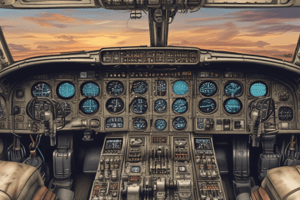Podcast
Questions and Answers
What is the primary purpose of using a Nicopress crimping tool?
What is the primary purpose of using a Nicopress crimping tool?
- To attach a thimble to the cable
- To reduce the diameter of the sleeve and form a strong bond (correct)
- To strip the insulation from the cable
- To cut the cable to a specific length
What is the correct order of compression when using a Nicopress sleeve?
What is the correct order of compression when using a Nicopress sleeve?
- Nearest the thimble, then centre, then end of the sleeve
- Centre compression, then nearest the thimble, then end of the sleeve (correct)
- End of the sleeve, then centre, then nearest the thimble
- End of the sleeve, then nearest the thimble, then centre
What is the purpose of applying a band of paint to the cable and sleeve?
What is the purpose of applying a band of paint to the cable and sleeve?
- To identify the type of cable used
- To indicate if the cable has slipped during inspection (correct)
- To provide additional grip to the sleeve
- To mark the cable for future maintenance
What is the minimum percentage of cable strength achieved by a Nicopress termination?
What is the minimum percentage of cable strength achieved by a Nicopress termination?
How many Nicopress sleeves are used to join two lengths of cable?
How many Nicopress sleeves are used to join two lengths of cable?
What is the purpose of the Nicopress gauge?
What is the purpose of the Nicopress gauge?
What is the purpose of applying a ring of brightly coloured paint around the end of the terminal and cable?
What is the purpose of applying a ring of brightly coloured paint around the end of the terminal and cable?
What is the purpose of the Proof-Load Test after the cable is completed with the terminals?
What is the purpose of the Proof-Load Test after the cable is completed with the terminals?
Where are cables most likely to wear or break?
Where are cables most likely to wear or break?
What is the primary method of inspecting cables for broken wires or strands?
What is the primary method of inspecting cables for broken wires or strands?
What should be done to inspect for corrosion in a cable?
What should be done to inspect for corrosion in a cable?
How often should cables be inspected?
How often should cables be inspected?
What should you avoid doing when bending the cable during inspection?
What should you avoid doing when bending the cable during inspection?
What is a critical fatigue area in aircraft control cable inspection?
What is a critical fatigue area in aircraft control cable inspection?
Why is it necessary to use a cloth to inspect the cable?
Why is it necessary to use a cloth to inspect the cable?
What may indicate the presence of a broken wire in the cable?
What may indicate the presence of a broken wire in the cable?
What is recommended to further inspect a suspected broken wire?
What is recommended to further inspect a suspected broken wire?
What publication recommends a procedure for inspecting aircraft control cables?
What publication recommends a procedure for inspecting aircraft control cables?
What is the recommended action for a cable assembly with a broken wire strand in a critical area?
What is the recommended action for a cable assembly with a broken wire strand in a critical area?
Why is it important to wipe corrosion-resistant stainless steel cables with LPS-3, Boeshield T-9, or Dinitrol ML?
Why is it important to wipe corrosion-resistant stainless steel cables with LPS-3, Boeshield T-9, or Dinitrol ML?
What is indicated by external wear patterns on a cable?
What is indicated by external wear patterns on a cable?
When should flexible and non-flexible cables be replaced?
When should flexible and non-flexible cables be replaced?
What occurs internally in a cable as wear takes place on the exterior surface?
What occurs internally in a cable as wear takes place on the exterior surface?
What causes the type of wear that occurs internally in a cable?
What causes the type of wear that occurs internally in a cable?
What is the primary purpose of using rig pins in aircraft control systems?
What is the primary purpose of using rig pins in aircraft control systems?
What is the tool used to check the tension of control cables?
What is the tool used to check the tension of control cables?
What is the purpose of a cable tension compensator assembly?
What is the purpose of a cable tension compensator assembly?
What is the reading on the cable tensiometer scale?
What is the reading on the cable tensiometer scale?
How are the risers on a cable tensiometer used?
How are the risers on a cable tensiometer used?
What is the purpose of the pointer lock on a cable tensiometer?
What is the purpose of the pointer lock on a cable tensiometer?
Flashcards are hidden until you start studying
Study Notes
Nicopress Process
- Nicopress sleeves are compressed into a cable using a special crimping tool, reducing the sleeve diameter and forming an extremely strong bond.
- The cable is passed through the sleeve and around the thimble, with about 1/8 in. visible beyond the sleeve.
- Three compressions are made: centre compression, then compression nearest the thimble, and finally compression at the end of the sleeve.
- A Nicopress termination produces 100% of the cable strength.
Nicopress Gauge and Splice
- Compressions are checked with a special Nicopress gauge, which ensures the sleeve fits snugly in the slot.
- Running splices can be made to join two lengths of cable using two Nicopress sleeves.
- When two sleeves are used correctly, the splice is approved as having the full cable strength.
Safety Feature and Testing
- A band of paint is applied to the cable and sleeve to assist during inspection; if broken, it indicates the cable has slipped and further inspection is required.
- A spot of paint is applied to the cable against the sleeve, and a ring of brightly coloured paint is applied around the end of the terminal and cable after testing.
- The cable is tested by loading it to 60% of its breaking strength, with the load applied gradually and held for at least 3 min.
Cable Inspection Practices
- Cables are carefully examined at each scheduled inspection, especially where they pass over pulleys or through fairleads.
- Wear and corrosion are the two most common problems with control cables.
- Inspect for broken wires or strands by wiping a clean, dry rag over the cable, and move the controls through their full range to check for wear.
- Check for corrosion by disconnecting the cable, bending it into a loop, and using a torch and magnifying glass to inspect.
Cable Wear and Corrosion
- Critical fatigue areas are defined as the working length of a cable where it runs over, under, or around a pulley, sleeve, or fairlead, or where it is flexed, rubbed, or worked in any manner.
- Close inspection of these areas must be made by passing cloth over the areas to snag on broken wires.
- Visual inspection must be made to detect broken wires, which may show up as a hairline crack in the wire.
- Cables with one broken wire strand located in a critical area must be replaced.
Corrosion Prevention
- Corrosion-resistant stainless steel cable is used in seaplanes and agricultural aircraft, which operate in environments conducive to corrosion.
- It is recommended to wipe these cables with LPS-3, Boeshield T-9, or Dinitrol ML to protect and lubricate the cables.
Cable Tension
- Cable tension is checked with a cable tensiometer, which must be placed in a clear area of each section of cable, midway from any quadrants, bell cranks, or surfaces.
- The tensiometer reading is converted to tension in pounds using a chart.
- Most large transport aircraft are fitted with a cable tension compensator assembly, which compensates for expansion and contraction of the airframe and regulates control cable tension accordingly.
Studying That Suits You
Use AI to generate personalized quizzes and flashcards to suit your learning preferences.



